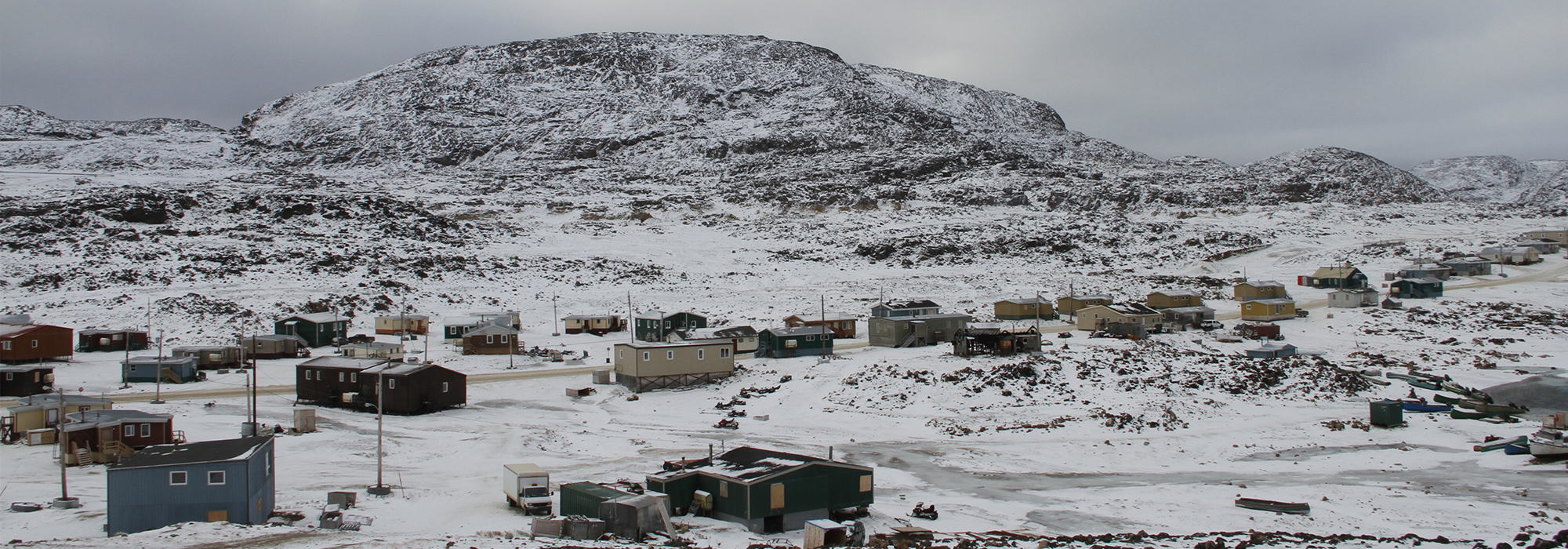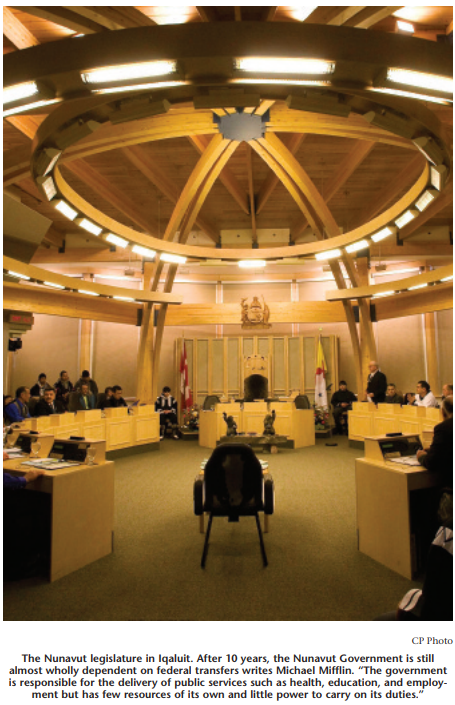
The Nunavut Land Claims Agreement (the Nunavut Agreement or NLCA) signed in 1993 provided the Inuit of Nunavut with a comprehensive compensation package of cash, lands and powers and, most importantly, the opportunity to control their own jurisdiction and their own public government in the Canadian federation. It is the realization of this later commitment, with the establishment of the Nunavut Territory on April 1, 1999, that we are celebrating this year.
Unfortunately, 10 years on and roughly $10 billion later, Nunavut is still the most financially dependent and underserviced jurisdiction in the country and is still experiencing severe social problems. On its 10th anniversary, it is opportune to ask why Nunavut has not been able to address these problems or create the conditions necessary to free itself from complete financial dependence on the federal government.
The answer to this question is not simple. Obviously, the challenges were overwhelming and 10 years is a very short period to meet them. But I would argue that a key part of the problem lays in the parallel public/Inuit governance structure created under the Nunavut Agreement. Essentially, there is a mismatch between responsibilities and capacity: the government is responsible for the delivery of public services such as health, education and employment but has few resources of its own and little power to carry on its duties. On the other hand, the land claims organization — Nunavut Tunngavik Incorporated (NTI) — was given ownership of all of the cash, lands, resource royalties and powers provided in the NLCA, but no responsibility in providing services to the people of the territory.
The story of how Nunavut came to have such a structure of governance is recounted elsewhere in this issue. Here I wish to discuss its impact on the Nunavut government. As I will explain, this de facto parallel system of governance keeps the Nunavut government wholly dependent on the federal government to finance even its basic operations. The degree to which Nunavut’s citizens can enjoy a quality of life on par with all Canadians will ultimately depend on the willingness of NTI to support the public government.
The self-sufficiency and prosperity of any society depends largely on the financial resources available to its government to provide public programs and services, to generate economic activity and to create employment. In Canada, all governments seek financial independence because of the greater control it affords them to provide culturally or regionally appropriate services to their citizens. The development of natural resources is one of the key means by which provinces and territories achieve economic independence. A fundamental attribute of all Canadian provinces is the ownership of lands and resources, and resulting royalties within their borders. For instance, under its terms of union Newfoundland received the right to all lands, mines, minerals and resulting royalties. Furthermore, in 2005, it received the right to be the principal beneficiary of the oil and gas resources off its shores, without any penalty to its equalization payments. It was through this right that the Newfoundland and Labrador government was able to lift itself out of economic dependency.
Nunavut also has significant valuable natural resources. In fact it is blessed with some of the world’s most abundant sources of energy and mineral resources. An estimated 10 percent of Canada’s total oil reserves, 20 percent of its natural gas reserves and significant deposits of uranium, diamonds, gold and iron ore are contained within Nunavut’s borders.
In 1993, the NLCA divided the ownership of these resources between NTI and the Government of Canada. The agreement transferred to NTI the right to mines, minerals and royalties on 18 percent (356,000 square kilometres) of the territory, while Canada retained the remainder (minus the communities, which are territorial responsibility). In addition, the Nunavut Agreement ensures that Canada pays resource royalties to NTI equivalent to 50 percent of the first $2 million of resource royalties earned annually and 5 percent of the rest.
In comparison, the Nunavut government owns no lands outside of its municipalities’ borders, receives no royalties from the development of its natural resources, and has no means of its own to fund its public services. Consequently, the Nunavut government has remained almost wholly dependent on federal transfers. It receives approximately $1.145 billion annually in transfer payments and targeted funding programs, representing a full 90 percent of its total budget.
In other words, the Nunavut Agreement effectively gave NTI one of the most important means through which the Nunavut government could ever hope to become financially independent from the federal government: resource development and resource royalties.
The Nunavut government owns no lands outside of its municipalities’ borders, receives no royalties from the development of its natural resources and has little means of its own to fund its public services. Consequently, the Nunavut government has remained almost wholly dependent on federal transfers.
Moreover, while the Nunavut government received the relatively small sum of $150 million as initial start-up funding, almost 12 times that amount was actually provided to Inuit under the terms of the Nunavut Agreement. Between 1993 and 2007, Canada transferred $1.173 billion in compensation to the Nunavut Trust controlled by NTI and three regional Inuit associations (RIA) (Qikiqtaani, Kivalliq, and Kitikmeot).
According to the deed of the Nunavut Trust, the money must be used for the general benefit of Inuit. The three RIAs control the investments made with the trust fund, whereas NTI controls the distribution of income made from those investments. While it is true that modest amounts of the investment income have been distributed as start-up funds for Inuit businesses, scholarships and hunter support programs, the trust has been primarily used to fund the operations of these four corporations and to fund their subsidiary businesses, but none has been used to help fund public services provided by the Nunavut government.
Under the terms of the Nunavut Agreement “no Major Development Project may commence until an IIBA is finalized.” This means that no mine, transportation corridor, hydroelectricity development or any other project can occur on the lands owned by NTI until an IIBA is concluded.
An impact and benefit agreement is a legal contract between a developer and the landowner (in this case, NTI or one of the regional Inuit associations) to provide compensation for the use of their lands. Compensation can include lucrative service contracts for enterprises owned by NTI or the RIAs, training and scholarship funding, housing and recreation facilities or financial compensation. On several occasions, the RIAs have become direct shareholders in the mineral development projects. In fact, while these corporations are not for profit, they fund and own in full or in part several mining, exploration construction and companies, airlines, cruise lines and retail industries.
Every year, agreements for tens of millions of dollars in contracts are concluded between NTI and multinational mining interests such as Areva Resources, Baffinland Iron Mines Corporation and Agnico-Eagle. But it is difficult to ascertain the true value of these Inuit Impact and Benefit Agreements (IIBAs), because the negotiations take place behind closed doors and their content is made confidential by NTI and the RIAs. The Nunavut government and the municipalities, whose citizens and services are most affected by major development projects, have no voice in the negotiations, and the Nunavut government has no influence over the distribution of benefits. Once they are concluded, only the government of Canada has access to the contents of IIBAs, not the Nunavut government or the general public.
If one compares the situation in Nunavut with those in similar jurisdictions, such as the Nunatsiavut land claims agreement in Newfoundland and Labrador, a clearer picture of the potential value of IIBAs emerges. For instance, agreements negotiated between the mining company Inco and the Inuit and Innu of Labrador included funding for a $15-million hospital, at least $1.2 million in recreation and wellness funding, and funding for scholarships and training. The socio-economic conditions in Nunatsiavut and the scale of mineral development are comparable to those in Nunavut. Thus, it seems the benefits that Nunavut could realize from major development are substantial.
Despite pleas from the Nunavut government and its municipalities, NTI and the RIAs have refused to provide any IIBA funding for areas of public government responsibility or allow communities to be involved in the negotiations. In 2006, Leona Aglukkaq (now the federal minister of health, then Nunavut’s minister of health and minister for the Status of Women Council) asked NTI and the RIAs to use IIBA negotiations to help fund women’s shelters. Earlier that year, the municipality of Cambridge Bay asked the NTI and the Regional Inuit Corporation to help fund its fledgling health and wellness programs with money from IIBAs. Similarly, the municipalities of Baker Lake, Kugluktuk and Cambridge Bay have asked to be part of IIBA negotiations in order to provide health and wellness programs with funding from major development projects. All met with no success. As a result, a real sense of injustice is growing among Nunavut’s citizens, whose communities lack basic public health and wellness programs and functioning municipal infrastructure.
The position taken by NTI and the three RIAs is that they are under no obligation to include communities in IIBA negotiations nor to use compensation money to fund services provided by the Nunavut government. In 2006, at a public hearing for a major mine, a panel of NTI and Kitikmeot Inuit Association officials told the municipality of Cambridge Bay that because the land claim stated that IIBAs are for Inuit, they cannot provide funding that “would provide benefits that would go to non-Inuit, even though the majority of those benefits might go to Inuit.”
The problem with such a response is that NTI and the RIAs control the only legal mechanism afforded by the Nunavut Agreement for leveraging benefits to Nunavut’s communities from major development projects. Given that Nunavut continues to suffer suicide rates 40 times higher than the national average, that approximately 50 percent of the population lives in overcrowded housing and that 76 percent of Inuit children do not finish high school, this unwillingness on the part of NTI and the RIAs to help fund community health and wellness programs delivered to a population whom the land claim was meant to benefit is, to say the least, questionable.
The ability to make exclusive decisions about all aspects of natural resource development is a central power enjoyed by provincial governments. It allows them to ensure that the negative social and environmental impacts of development are mitigated and that maximum economic benefits are realized by their communities and their citizens. Under the terms of the Constitution Act 1867, provincial governments are given exclusive powers for the exploration, development, conservation and management of natural resources (this power was also extended to the Yukon Territory in 2002).
Historically, territorial governments have not been given exclusive powers over lands and resources before decades of negotiations.
In comparison, and unlike other territories, Nunavut has an agreement that provides Inuit with decision-making power over the “use, management and conservation of land, water and resources, including the offshore.” However, rather than empowering the Nunavut government, this decision-making power was given to four independent co-management boards, which regulate all aspects of natural resource development in Nunavut.
Comanagement is a system of power-sharing commonly negotiated in Aboriginal land claims settlements to give greater decision-making authority to Aboriginal groups over Crown lands and resources. In theory, comanagement arrangements allow Aboriginal people greater decision-making authority over the lands, waters and resources on which they depend for their livelihood. Most of the major land claims in Canada, such as the Nunavik (Quebec), Nunatsiavut (Labrador), Inuvialuit (NWT) and Gwich’in (NWT), include comanagement arrangements for lands and resources.
In Nunavut, the decision-making power over lands and resources is distributed among four independent comanagement boards: the Nunavut Impact Review Board, Planning Commission, Water Board and Surface Rights Tribunal. The board members of each organization are appointed equally by the federal government, the territorial government and NTI. Each of these boards issues its own authorizations, has its own office, infrastructure, staff and budget, and is funded by the federal government, at $13 million annually.
The intention of the comanagement model is to give greater decisionmaking powers to Aboriginal people over the management of their lands and resources. For an Aboriginal group living in a province or territory and representing a minority of the population, comanagement would, in theory, create a more equitable distribution of control between its land claims organization and a more powerful provincial or territorial government.
The situation in Nunavut is quite different, because there Inuit form the large majority of the population and have majority control over the territorial government. The comanagement system removes decision-making power from the public government and divides it among three interests (federal, territorial and Inuit). In effect, no one group is accountable for resource management decisions or has the power to make exclusive decisions on development. Without these critical decision-making powers, the Nunavut government has little influence over how Nunavut’s natural resources are developed, or what benefits its communities will derive. In practice, Nunavut’s comanagement system results only in a lengthier and costlier process that fails to deliver any added benefits to Nunavut’s citizens.
In fact, Nunavut’s regulatory system has proven wholly unworkable and is a roadblock to the development of Nunavut’s resources. Over the past five years, reports by the auditor general of Canada and the Department of Indian Affairs and Northern Development have observed the failure of the dozen or more land and resource comanagement boards set up in Nunavut and the Northwest Territories. They also report a lack of accountability, direction and guidance and fundamental technical capacity issues. The mineral industry, the Nunavut government and the government of Canada have all called for a major overhaul of Nunavut’s land and resource management system.
In 2007, the federal government commissioned Montreal-based lawyer Paul Mayer to conduct an inquiry to determine the feasibility of devolving more powers to the Nunavut government. His report concluded that one of the largest roadblocks to further devolution of land and resource powers to the Nunavut government was the regulatory system of comanagement boards, which did not create a climate that encouraged investment. Moreover, the report concluded that the land and resource comanagement boards “do not have the ability to manage the regulatory process,” and that they “have no clear mandate and do not seem to understand where their jurisdiction begins or ends.”
Ultimately, Nunavut’s success as a legitimate equal in the Canadian federation will depend entirely on the support given to the Nunavut government by NTI. All of the powers and resources necessary for Nunavut to prosper have been negotiated for and have been received by Nunavut’s land claims organizations. All that is needed is for Nunavut’s leaders to finish the great nation-building project that they started by empowering their own Nunavut government with the same powers and resources given to every other province in Canada to allow them to provide for their citizens.
To this end, I propose two short-and two long-term solutions for the G future:
- First, NTI and the Nunavut government should negotiate targeted and conditional transfers that would allow the Nunavut government to use for the benefit of Nunavummiut the more than $1 billion held by the Nunavut Trust, as well as additional resource royalties earned from Inuit-owned lands. These conditional transfers would target priority social programs and services for Inuit. Already, NTI produces an annual report on the status of Inuit culture and society and identifies priorities for health care, education, housing and other issues. NTI now has only to provide the Nunavut government with the money to help carry out these initiatives.
- Secondly, the regional Inuit associations and the Nunavut government should negotiate targeted conditional funding transfers to allow the Nunavut government to improve health and wellness programs in the communities most affected by major resource development. Most of these communities already outlined their priorities during the consultation process for major development projects.
- Third, NTI, the federal government, and the Nunavut government should restructure Nunavut’s land and resource management system by eliminating the redundant comanagement boards. Over the past decade this system has proven to be incapable of managing Nunavut’s regulatory process.
- Finally, NTI could provide the Nunavut government with the means to lift itself out of financial dependency and improve services to Nunavut’s citizens by transferring its exclusive powers for the exploration, development, conservation and management of natural resources to the Nunavut government on the 356,000 square kilometres of land transferrred to Inuit by the Nunavut Agreement.
In 2008, NTI launched a $1-billion lawsuit against the Government of Canada for a perceived lack of progress towards realizing the social, cultural and economic objectives of the Nunavut Agreement. In pursuing this course of action, NTI has failed to understand its own role in Nunavut’s lack of progress. For 10 years, NTI has denied the Nunavut government access to the cash, lands and powers that the Nunavut Agreement provided and that could help the Nunavut government respond to the needs of its citizens.
The Inuit of Nunavut have successfully negotiated for the right to sit as legitimate equals in the Canadian federation. No amount of legal redress will make a difference to Nunavut or its citizens if NTI cannot support the government it created. Ultimately, it is up to Nunavut Tunngavik Incorporated to decide whether it will use the benefits it won in the Nunavut Agreement to help lift Nunavut out of financial dependency. Only with NTI’s support will the Nunavut government have any chance of providing its citizens with a standard of living that is on a par with that of all Canadians.
Photo: Shutterstock








